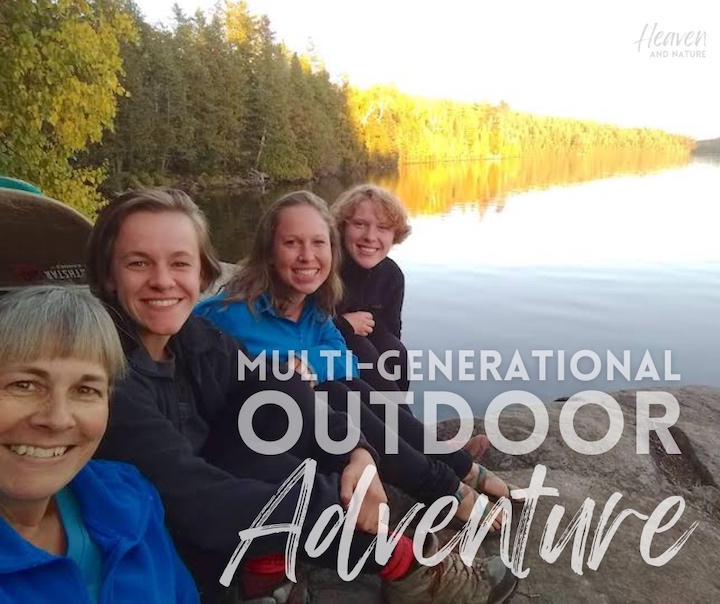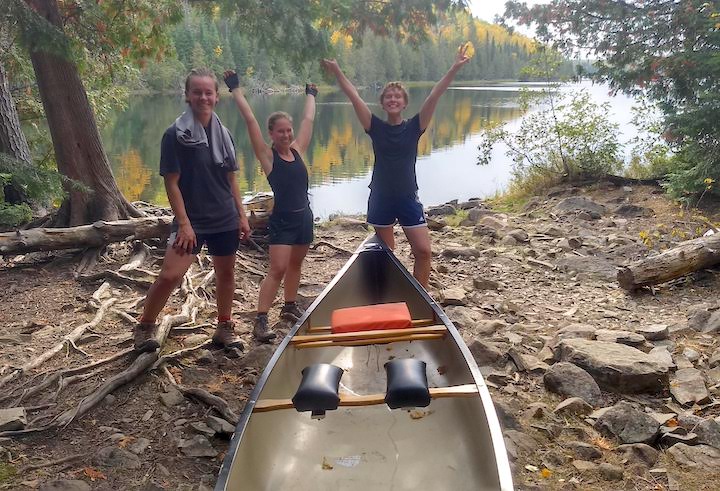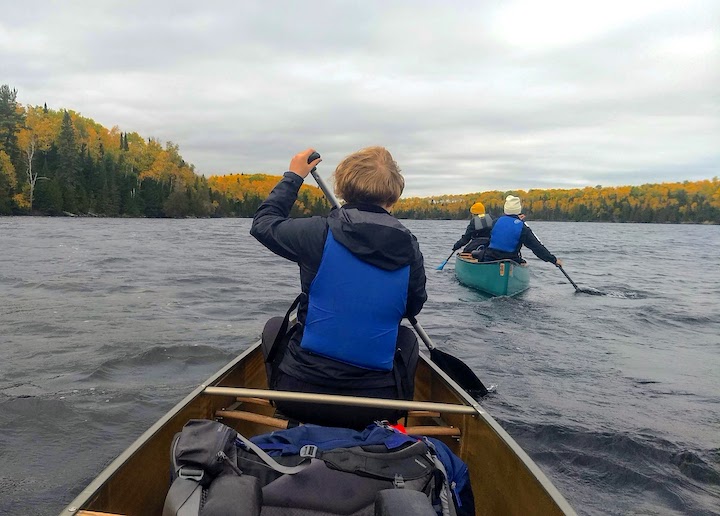Back in September of 2021 my daughter Jamie and her friend Emilie started to plan a Boundary Waters canoe trip. Before I knew it, they invited me to go, too.

The Boundary Waters in late September?
I knew it could be really cold…raining…snowing, even. But I also knew the fall color peaks up there about that time. It could be warm and sunny. The nights would definitely be cool enough to sleep well. And—most importantly—there would be no bugs!
I couldn’t resist.
They invited another friend, Rachel (all three girls in their 20s), who’d been wanting to try a BWCA trip ever since she moved from Washington to Minnesota five years ago.
We were only out for three days and two nights. The weather ended up glorious for the first two days and cool and overcast for Day 3, but no rain. Any wind we had was at our backs while we paddled. We found a great campsite for each night (our second one thanks to another group of very kind canoe trip veterans).

It was a wonderful time—both outdoors in that beautiful place and our time together.
Of course, I’m always glad to have time with Jamie. Now that she’s married and living her own life, I don’t take time with her for granted.
And I’m blessed to have many friends who are in their 20s, like Jamie and our sons. Most of them are young women from my home church, like Emilie and Rachel. Some of us are in worship ministry together, some not. Most of us enjoy outdoor activities, so I often invite one or more along when I do something fun.
Here are some of the joys I’ve found in these kinds of multi-generational adventures like a wilderness canoe trip:
We Older Ones can Pass On Our Experience
In this case, I was able to pass on my experience doing canoe trips in the Boundary Waters.
When I was in my 20s back in the late 80s and early 90s, I volunteered two of my summers at Okontoe Fellowship. Back in those days they had youth camps for junior and senior high school kids, and part of their programming was a 5-10 day canoe trip.

So I learned both how the process of canoe tripping (hadn’t done it before my first summer there) and how to take teens out on a multi-day trip. I took probably 6-7 trips on various routes, plus a few more since then.
These ladies had various levels of canoeing and canoe trip experience: Jamie had grown up canoeing with our family, had been on many day trips and one multi-day trip. Emilie hadn’t canoed much but has camped a lot. Rachel had very limited experience in all of it, but lots of enthusiasm and a hunger to learn.
It was a joy for me to be out with them and teach them whatever I could.
The Younger Generation Can Hold Our Feet to the Fire
I’ve told my daughter and many others of her generation how much further along on their faith journey they are than I and my friends were at their age. Not that we didn’t love Jesus—we did! But the spiritual maturity I see in these ladies and other young adults I know is astounding.
It’s both humbling and inspiring.

It was fun to engage each other on various topics around our meals, at portages, while paddling. These ladies a generation younger than me have different perspectives on things, different challenges. More fire, I’d say, for the things of God.
That’s one of the many reasons I love being with them!
The ‘Youngers’ Help Us ‘Olders’ with the Physical Work
This is especially noticeable on a multi-day canoe trip when there’s a lot of portaging involved! For those who aren’t familiar with it:
- A Boundary Waters canoe trip means we follow a route on a map between a series of lakes, camping in the backcountry each night.
- Between each lake is a portage—a hiking trail that usually involves rocks, tree roots, mud, fallen trees and hills.
- For each portage, we unload the canoes and carry it all over the portage into the next lake.
- Once we find an open campsite (these are marked on the map, too) we set up camp for the night.
- The next day we do it again.

This particular route included a rather infamous portage known as “the Johnson Falls portage.” It’s known for its beauty (the lovely Johnson Falls, a short hike off the main portage), its length (232 rods, almost 3/4 of a mile) and its elevation gain. Lots of people only do it as a day trip from their campsite.
We took it as part of our route. We portaged all our packs and the canoes over it from the north side, which meant taking that steep switchback trail uphill. And because we couldn’t take all our gear and the canoes in one trip, we hiked it three times, as we did all the portages of that trip.
[Then we hiked almost all the way back to the beginning so we could get some play time at the waterfall! Another two trips, making it close to 4 miles on that portage. My legs were complaining loudly that evening!]
It’s wonderful for a 50s woman like me to be with three young, strong, hard-working mid-20s women on a trip like this! Seriously. They pulled more than their share of the weight with the physical work.
Will I be involved in more multi-generational outdoor adventures? Absolutely yes! I hope you will be, too.

Here’s more…
- How to Raise Our Girls to Love the Outdoors
- Camping and Trail Food 101
- Shalom: Its Meaning and Promise
- 11 Wonderful Things in Our Natural World - February 6, 2025
- What Kind of Exercise Is Best? - January 10, 2025
- 116 Verses in the Bible that Talk About Light - December 10, 2024
